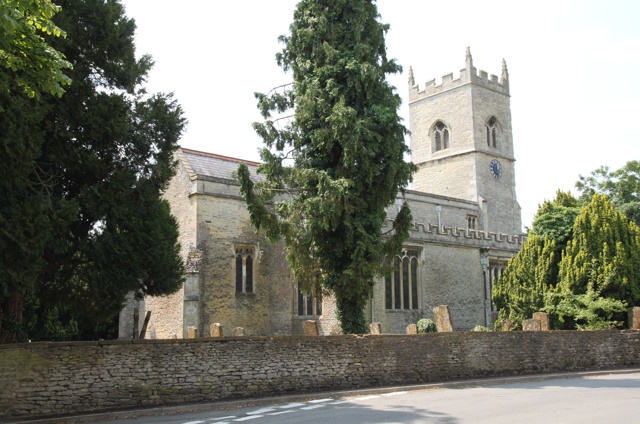


























The Church of St. Mary and St. Edburga, Stratton Audley
The church of St. Mary and St. Edburga at Stratton Aydley is a stone building comprising a chancel, clerestoried nave, north and south aisles, north porch, and west tower. There is a sanctus bell-cote above the chancel arch. The church was largely rebuilt in the 13th and 14th centuries, but a 12th-century doorway (now disused) remains in the south wall of the south aisle. It is probably not in its original position. The north aisle was added early in the 13th century, and the clustered columns which separate it from the nave are of this period. The remains of a blocked-up lancet at the west end of the south aisle imply that this, too, was added or rebuilt during the 13th century, but it was widened in the 14th century, and its arcade is of later date than that on the north side. Early in the 14th century the east window of the north aisle was rebuilt, and towards the end of the century a battlemented west tower was erected within the west wall of the nave. In the 15th century the chancel was rebuilt and the nave clerestory added. Several additional windows were inserted in the aisles in the course of this century, and the ornate battlemented porch is of the same period. Few records of repairs to the church have survived. They were ordered in 1757, when a new font-cover was provided, again in 1804, and in 1853 the roof was repaired and the floor relaid. In 1861 the church was fully restored by the architect Roger Smith. The restoration, which cost about £800, included rebuilding the chancel arch, putting on a new chancel roof, releading the nave roof, removing the chancel screen, and reseating both nave and aisles. The church has electric light. When the church was visited by Wood in the second half of the 17th century the windows of the north and south aisles contained armorial glass. There are still early 14th-century shields in the west window of the south aisle (Clare) and the east window of the north aisle (Segrave and Sandford or Fiennes). There is also some medieval glass in one of the chancel windows. The ancient octagonal font is of uncertain date; the pulpit is Jacobean; an elm table given by the churchwardens is dated 1636, and a tower screen of carved oak designed by T. Lawrence Dale was erected in the 20th century. There is a fine marble tomb to Sir John Borlase (d. 1688/9), represented as a Roman in recumbent position with two weeping figures on either side. There are also tablets to Sir John's brother Baldwin (d. 1678) and to Sir John Borlase Warren (d. 1822). There are inscriptions to Edmund Woodward (d. 1713/14) and family, and to the 18th-century Bush family. Later memorial tablets are to George Glen (d. 1885), Major-Gen. Charles Cavendish, 3rd Baron Chesham (d. 1907), Lt.-Col. George Gosling (d. 1915), Major-Gen. Merton Beckwith-Smith (d. 1942), and Norman Joseph Goss (d. 1944). In 1552 the church was richly furnished with a silver chalice gilded within, a silver paten, a number of vestments of velvet and silk, and two copes. In 1805 it owned a pewter tankard and cup. The present plate is notable for its fine Restoration pewter service, which is unique of its kind and includes a chalice made by Richard Mastead in about 1665–75, a small flagon (c. 1700), and two plates dating from the late 17th century. There is also a large silver paten (1777), a chalice (1836), and a silver flagon, all given to the church in 1842 by the curate and churchwardens. The tower has a ring of five bells: the second, third, and fourth are late 17th-century; the treble and tenor 18th-century and inscribed with the names of the churchwardens. The bells were rehung in 1902 and part of the original frame, dated 1636, is preserved in the church. In 1552 there were three bells and a sanctus bell. The last was recast in the 17th century and in 1955 was in the tower. The church did not acquire a churchyard until after 1455 at the earliest, when the villagers acquired parochial independence of Bicester. The remains of the medieval cross can still be seen, and there is a cross by W. R. Lethaby to members of the armed services who died in the First World War. The register for marriages begins in 1755 and for baptisms and burials in 1813. The earlier ones, which began in 1696 and were there in 1823, have probably been destroyed. Some of the remaining books have been damaged by fire and water. Historical information about The Church of St. Mary and St. Edburga is provided by 'Parishes: Stratton Audley', in A History of the County of Oxford: Volume 6, ed. Mary D Lobel (London, 1959), pp. 324-333. British History Online http://www.british-history.ac.uk/vch/oxon/vol6/pp324-333 [accessed 21 February 2023]. The Church of St. Mary and St. Edburga is a Grade I listed building. For more information about the listing see CHURCH OF ST MARY AND ST EDBURGA, Stratton Audley - 1046404 | Historic England. For more information about The Church of St. Mary and St. Edburga see Parishes: Stratton Audley | British History Online (british-history.ac.uk). |

